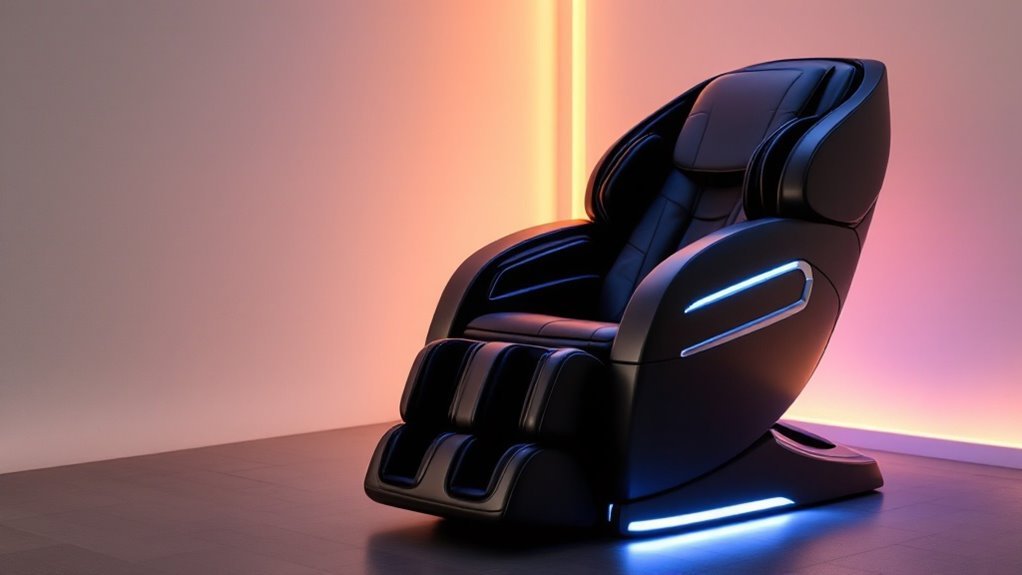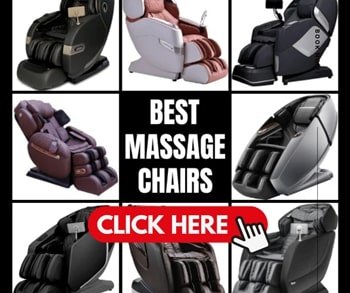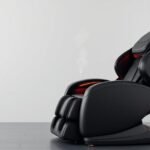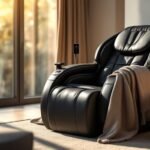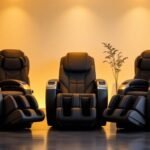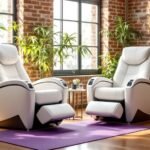AI-powered massage chairs integrate advanced sensing technology and machine learning to deliver personalized therapeutic experiences. These smart chairs create detailed body maps through pressure sensors, detecting muscle tension patterns and automatically adjusting massage techniques in real-time. The systems track wellness progress while optimizing circulation and mobility, offering consistent quality comparable to human massage therapists. Understanding how this technology transforms traditional massage chairs reveals its full potential for holistic physical and mental well-being.
Key Takeaways
- AI-powered massage chairs use advanced sensors to create real-time body maps and detect muscle tension for personalized massages.
- Machine learning algorithms continuously improve massage performance by adapting to user feedback and physical responses.
- Smart massage chairs offer customized therapeutic experiences comparable to human therapists through automated pressure and technique adjustments.
- Biometric tracking systems monitor wellness progress and optimize future sessions based on collected user data.
- These chairs deliver consistent, high-quality massages while supporting both physical recovery and mental well-being through stress reduction.
How AI Technology Revolutionizes Massage Chair Performance
Artificial intelligence transforms traditional massage chairs into sophisticated wellness devices through advanced sensing and adaptation capabilities.
AI-powered pressure sensors map users’ body shapes, muscle tension patterns, and skeletal structures in real-time, enabling precise customization of massage intensity and techniques.
Advanced sensor technology creates a real-time body map, allowing massage chairs to deliver perfectly tailored therapeutic experiences for each user.
Machine learning algorithms analyze this biometric data to identify best massage patterns and pressure points specific to each user’s needs. The chairs continuously refine their performance by learning from user feedback and physiological responses.
Advanced AI systems can detect subtle changes in muscle tension and automatically adjust massage routines, while also recognizing signs of discomfort or stress.
This technological integration allows massage chairs to provide therapeutic experiences that rival human massage therapists, with consistent quality and personalized attention to individual body requirements.
The Benefits of Smart Massage Technology for Personal Wellness
Smart massage technology delivers numerous wellness benefits that extend beyond traditional relaxation. The integration of artificial intelligence with massage chairs creates personalized therapeutic experiences that adapt to individual needs and physical conditions.
- Real-time body scanning technology identifies stress points and muscle tension, allowing for targeted treatment that reduces chronic pain and improves mobility.
- AI-driven massage programs optimize blood circulation and lymphatic drainage through precise pressure application and rhythm adjustments.
- Smart scheduling features encourage regular massage sessions, promoting better sleep patterns and stress management.
- Biometric feedback systems track wellness progress over time, helping users understand their body’s response to different therapeutic techniques.
These advanced features work together to create a thorough wellness solution that supports both physical recovery and mental well-being.
FAQ
How Long Do AI Massage Chairs Typically Last Before Needing Replacement?
Massage chairs typically last 8-15 years with proper maintenance and regular use.
Mechanical components usually provide 1,500-2,000 hours of operation before requiring service. Higher-end models tend to last longer due to superior build quality and components.
Factors affecting longevity include frequency of use, maintenance schedule, user weight, and environmental conditions.
Annual professional servicing can extend the chair’s lifespan markedly.
Can AI Massage Chairs Be Harmful for People With Specific Medical Conditions?
Massage chairs can potentially pose risks for individuals with certain medical conditions.
People with osteoporosis, recent injuries, blood clots, heart problems, or pregnancy should consult healthcare providers before use. The strong mechanical pressure could aggravate existing conditions or cause complications.
Those with metal implants, acute inflammation, or severe back problems should exercise particular caution. Some conditions may require complete avoidance of mechanical massage therapy.
What Maintenance Is Required to Keep an AI Massage Chair Functioning Properly?
Regular maintenance for massage chairs includes dusting and cleaning the upholstery, checking electrical connections, lubricating mechanical parts, and ensuring proper alignment of rollers and tracks.
Users should inspect power cords for damage, tighten loose screws, and test safety features monthly.
Professional servicing is recommended annually to calibrate sensors, update software, and verify all components are functioning correctly.
Following the manufacturer’s maintenance schedule extends the chair’s lifespan.
Are AI Massage Chairs Significantly Louder Than Traditional Massage Chairs?
Like a whisper in a library, modern massage chairs generally operate at similar noise levels regardless of their technology.
While AI-powered models contain additional electronic components, manufacturers prioritize quiet operation through improved engineering and sound-dampening materials.
The primary sounds users hear are the mechanical movements of rollers and airbags, which typically range between 45-60 decibels – comparable to traditional massage chairs.
Do AI Massage Chairs Work Effectively Through Thick Clothing or Blankets?
Massage chairs can effectively work through light to medium-weight clothing, but thick garments or blankets greatly reduce their effectiveness.
The rollers and mechanisms need reasonable contact with the body to properly detect pressure points and deliver targeted massage.
While some sensation will transfer through heavy layers, ideal results require thinner clothing that allows the chair’s sensors and massage components to accurately assess and treat the user.
